Tensile and Shear Mechanical Characteristics of Longmaxi Shale Laminae Dependent on the Mineral Composition and Morphology
Abstract
:1. Introduction
2. Materials and Methods
3. Results
3.1. Tensile Strength
3.2. Shear Strength
3.3. Tensile Fracture Morphology
3.4. Shear Fracture Surface Morphology
4. Discussion
5. Conclusions
- (1)
- Tensile strength of the Longmaxi Shale laminae fluctuated over five levels: I (7–8 MPa), II (6–7 MPa), III (5–6 MPa), IV (2–5 MPa), and V (0–2 MPa), mainly corresponding to the laminae Cal, Py, Cal-Oc, Py-Oc, and Oc, respectively.
- (2)
- Shear strength parameters ranged from 22.50–29.64 MPa for cohesion and 37.29–43.60° for internal friction angle. The cohesion was strongly related to the fracture surface roughness of different laminae.
- (3)
- According to the fracture modes, the calcite laminae have a high influence on the tensile fracturing of shale. Our study suggests that the geometry and the properties of calcite laminae should receive more attention during the design of shale gas exploration.
Author Contributions
Funding
Acknowledgments
Conflicts of Interest
References
- Ilgen, A.G.; Heath, J.E.; Akkutlu, I.Y.; Bryndzia, L.T.; Cole, D.R.; Kharaka, Y.K.; Kneafsey, T.J.; Milliken, K.L.; Pyrak-Nolte, L.J.; Suarez-Rivera, R. Shales at all scales: Exploring coupled processes in mudrocks. Earth Sci. Rev. 2017, 166, 132–152. [Google Scholar] [CrossRef] [Green Version]
- Lei, Y.; Luo, X.; Wang, X.; Zhang, L.; Jiang, C.; Yang, W.; Yu, Y.; Cheng, M.; Zhang, L. Characteristics of silty laminae in Zhangjiatan Shale of southeastern Ordos Basin, China: Implications for shale gas formation. AAPG Bull. 2015, 99, 661–687. [Google Scholar] [CrossRef]
- Rokosh, D.; Pawlowicz, J.; Anderson, S.; Berhane, M.; Beaton, A. Shale fabric, mineralogy and effective porosity of the Upper Colorado Group. In Frontiers +Innovation; Alberta CSPG CSEG CWLS Convention: Calgary, AB, Candada, 2009; pp. 572–576. [Google Scholar]
- Na, S.; Sun, W.; Ingraham, M.D.; Yoon, H. Effects of spatial heterogeneity and material anisotropy on the fracture pattern and macroscopic effective toughness of Mancos Shale in Brazilian tests. J. Geophys. Res. Solid Earth 2017, 122, 6202–6230. [Google Scholar] [CrossRef] [Green Version]
- Li, H.; Lai, B.; Liu, H.-H.; Zhang, J.; Georgi, D. Experimental Investigation on Brazilian Tensile Strength of Organic-Rich Gas Shale. SPE J. 2017, 22, 148–161. [Google Scholar] [CrossRef]
- Chen, L.; Lu, Y.; Jiang, S.; Li, J.; Guo, T.; Luo, C. Heterogeneity of the Lower Silurian Longmaxi marine shale in the southeast Sichuan Basin of China. Mar. Pet. Geol. 2015, 65, 232–246. [Google Scholar] [CrossRef]
- Dong, T.; Harris, N.; Ayranci, K.; Twemlow, C.E.; Nassichuk, B.R. Porosity characteristics of the Devonian Horn River shale, Canada: Insights from lithofacies classification and shale composition. Int. J. Coal Geol. 2015, 141, 74–90. [Google Scholar] [CrossRef]
- Rybacki, E.; Meier, T.; Dresen, G. What controls the mechanical properties of shale rocks?—Part II: Brittleness. J. Pet. Sci. Eng. 2016, 144, 39–58. [Google Scholar] [CrossRef] [Green Version]
- Rickman, R.; Mullen, M.J.; Petre, J.E.; Grieser, W.V.; Kundert, D. A practical use of shale petrophysics for stimulation design optimization: All shale plays are not clones of the Barnett Shale. In Proceedings of the SPE Annual Technical Conference and Exhibition, Denver, CO, USA, 1 January 2008; pp. 1–11. [Google Scholar] [CrossRef] [Green Version]
- Eliyahu, M.; Emmanuel, S.; Day-Stirrat, R.J.; Macaulay, C.I. Mechanical properties of organic matter in shales mapped at the nanometer scale. Mar. Pet. Geol. 2015, 59, 294–304. [Google Scholar] [CrossRef]
- Kumar, V.; Sondergeld, C.H.; Rai, C.S. Nano to Macro Mechanical Characterization of Shale. In Proceedings of the SPE Annual Technical Conference and Exhibition, San Antonio, TX, USA, 1 January 2012; pp. 1–23. [Google Scholar] [CrossRef]
- Sone, H.; Zoback, M.D. Mechanical properties of shale-gas reservoir rocks—Part 1: Static and dynamic elastic properties and anisotropy. Geophysics 2013, 78, D381–D392. [Google Scholar] [CrossRef] [Green Version]
- Alqahtani, A.A.; Mokhtari, M.; Tutuncu, A.N.; Sonnenberg, S. Effect of Mineralogy and Petrophysical Characteristics on Acoustic and Mechanical Properties of Organic Rich Shale. In Proceedings of the Unconventional Resources Technology Conference, Denver, CO, USA, 12–14 August 2013; pp. 399–411. [Google Scholar] [CrossRef]
- Dong, N.B.H.T.; Yang, S. The impact of rock composition on geomechanical properties of a shale formation: Middle and Upper Devonian Horn River Group shale, Northeast British Columbia, Canada. AAPG Bull. 2017, 101, 177–204. [Google Scholar] [CrossRef]
- Qin, X.; Wang, Z.; Yu, H.; Chen, H.; Lei, Y.; Luo, X.; Zhang, L.; Jiang, C.; Gao, C. A new shale brittleness evaluation method based on rock physics and mineral compositions. Nat. Gas Geosci. 2016, 27, 1924–1932. [Google Scholar]
- Vervoort, A.; Min, K.-B.; Konietzky, H.; Cho, J.-W.; Debecker, B.; Dinh, Q.-D.; Frühwirt, T.; Tavallali, A. Failure of transversely isotropic rock under Brazilian test conditions. Int. J. Rock Mech. Min. Sci. 2014, 70, 343–352. [Google Scholar] [CrossRef]
- Mokhtari, M.; Bui, B.T.; Tutuncu, A.N. Tensile Failure of Shales: Impacts of Layering and Natural Fractures. In Proceedings of the SPE Western North American and Rocky Mountain Joint Meeting, Denver, CO, USA, 17–18 April 2014; Society of Petroleum Engineers: Denver, CO, USA, 2014; p. 23. [Google Scholar] [CrossRef]
- Tan, J.; Horsfield, B.; Fink, R.; Krooss, B.; Schulz, H.-M.; Rybacki, E.; Zhang, J.; Boreham, C.J.; Van Graas, G.; Tocher, B.A. Shale Gas Potential of the Major Marine Shale Formations in the Upper Yangtze Platform, South China, Part III: Mineralogical, Lithofacial, Petrophysical, and Rock Mechanical Properties. Energy Fuels 2014, 28, 2322–2342. [Google Scholar] [CrossRef]
- Cheng, Y.; Wong, L.N.Y. Microscopic Characterization of Tensile and Shear Fracturing in Progressive Failure in Marble. J. Geophys. Res. Solid Earth 2018, 123, 204–225. [Google Scholar] [CrossRef]
- Huang, X.; Haimson, B.; Plesha, M.; Qiu, X. An investigation of the mechanics of rock joints—Part I. Laboratory investigation. Int. J. Rock Mech. Min. Sci. Géoméch. Abstr. 1993, 30, 257–269. [Google Scholar] [CrossRef]
- Bahaaddini, M.; Hagan, P.; Mitra, R.; Khosravi, M.H. Experimental and numerical study of asperity degradation in the direct shear test. Eng. Geol. 2016, 204, 41–52. [Google Scholar] [CrossRef]
- Price, D.G.; de Freitas, M.; Hack, H.; Higginbottom, I.E.; Knill, J.L.; Maurenbrecher, M. Engineering Geology: Principles and Practice; Springer: Berlin/Heidelberg, Germany, 2009; p. 450. [Google Scholar]
- Abousleiman, Y.N.; Hoang, S.K.; Tran, M.H. Mechanical characterization of small shale samples subjected to fluid exposure using the inclined direct shear testing device. Int. J. Rock Mech. Min. Sci. 2010, 47, 355–367. [Google Scholar] [CrossRef]
- Frash, L.P.; Carey, J.W.; Lei, Z.; Rougier, E.; Ickes, T.; Viswanathan, H.S. High-stress triaxial direct-shear fracturing of Utica shale and in situ X-ray microtomography with permeability measurement. J. Geophys. Res. Solid Earth 2016, 121, 5493–5508. [Google Scholar] [CrossRef]
- Chen, J.; Lan, H.; Macciotta, R.; Wu, Y.; Li, Q.; Zhao, X. Anisotropy rather than transverse isotropy in Longmaxi shale and the potential role of tectonic stress. Eng. Geol. 2018, 247, 38–47. [Google Scholar] [CrossRef]
- Lyu, Q.; Long, X.; Ranjith, P.; Tan, J.; Kang, Y. Experimental investigation on the mechanical behaviours of a low-clay shale under water-based fluids. Eng. Geol. 2018, 233, 124–138. [Google Scholar] [CrossRef]
- ISRM. Suggested methods for determining tensile strength of rock materials. Int. J. Rock Mech. Min. Sci. Geomech. Abstr. 1978, 15, 99–103. [Google Scholar]
- Tan, X.; Konietzky, H.; Frühwirt, T.; Dan, D.Q. Brazilian Tests on Transversely Isotropic Rocks: Laboratory Testing and Numerical Simulations. Rock Mech. Rock Eng. 2014, 48, 1341–1351. [Google Scholar] [CrossRef]
- Li, W.; Jin, C.; Cusatis, G. Integrated Experimental and Computational Characterization of Shale at Multiple Length Scales. In New Frontiers in Oil and Gas Exploration; Springer International Publishing AG: Cham, Switzerland, 2016; pp. 389–434. [Google Scholar]
- Jin, Z.; Li, W.; Jin, C.; Hambleton, J.; Cusatis, G. Anisotropic elastic, strength, and fracture properties of Marcellus shale. Int. J. Rock Mech. Min. Sci. 2018, 109, 124–137. [Google Scholar] [CrossRef] [Green Version]
- Kassis, S.; Sondergeld, C.H. Fracture Permeability of Gas Shale: Effect of Roughness, Fracture Offset, Proppant, and Effective Stress. In Proceedings of the International Oil and Gas Conference and Exhibition in China, Beijing, China, 1 January 2010; p. 17. [Google Scholar]
- Thomas, T. Characterization of surface roughness. Precis. Eng. 1981, 3, 97–104. [Google Scholar] [CrossRef]
- Simpson, N.D.J.; Stroisz, A.; Bauer, A.; Vervoort, A.; Holt, R.M. Failure Mechanics of Anisotropic Shale During Brazilian Tests. In Proceedings of the 48th U.S. Rock Mechanics/Geomechanics Symposium, Minneapolis, MN, USA, 18 August 2014; p. 13. [Google Scholar]
- Mighani, S.; Sondergeld, C.H.; Rai, C. Observations of Tensile Fracturing of Anisotropic Rocks. SPE J. 2016, 21, 1289–1301. [Google Scholar] [CrossRef]
- Gale, J.; Reed, R.M.; Holder, J. Natural fractures in the Barnett Shale and their importance for hydraulic fracture treatments. AAPG Bull. 2007, 91, 603–622. [Google Scholar] [CrossRef]
- Padin, A.; Tutuncu, A.N.; Sonnenberg, S. On the Mechanisms of Shale Microfracture Propagation. In Proceedings of the SPE Hydraulic Fracturing Technology Conference, The Woodlands, TX, USA, 4–6 February 2014. [Google Scholar]

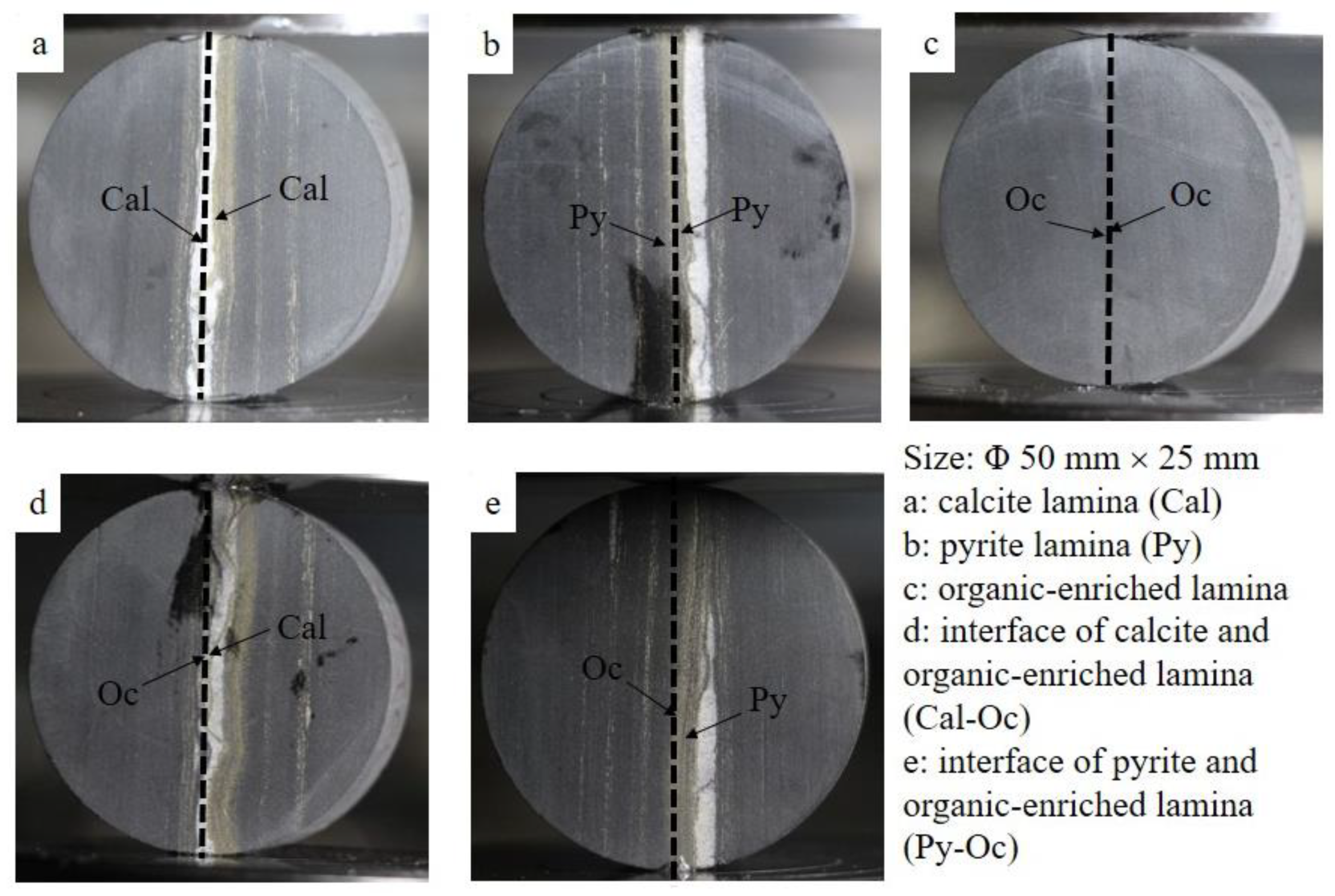
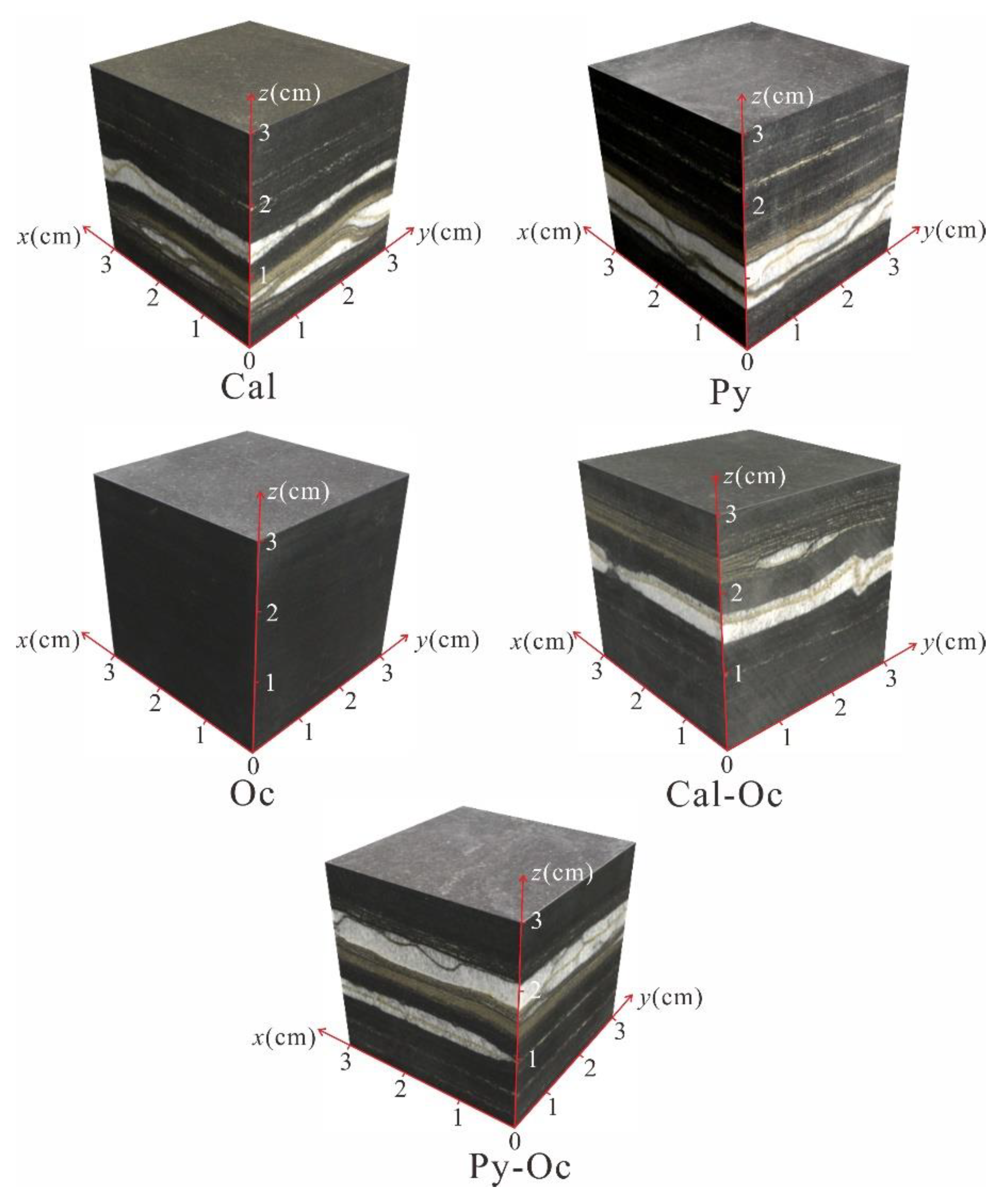
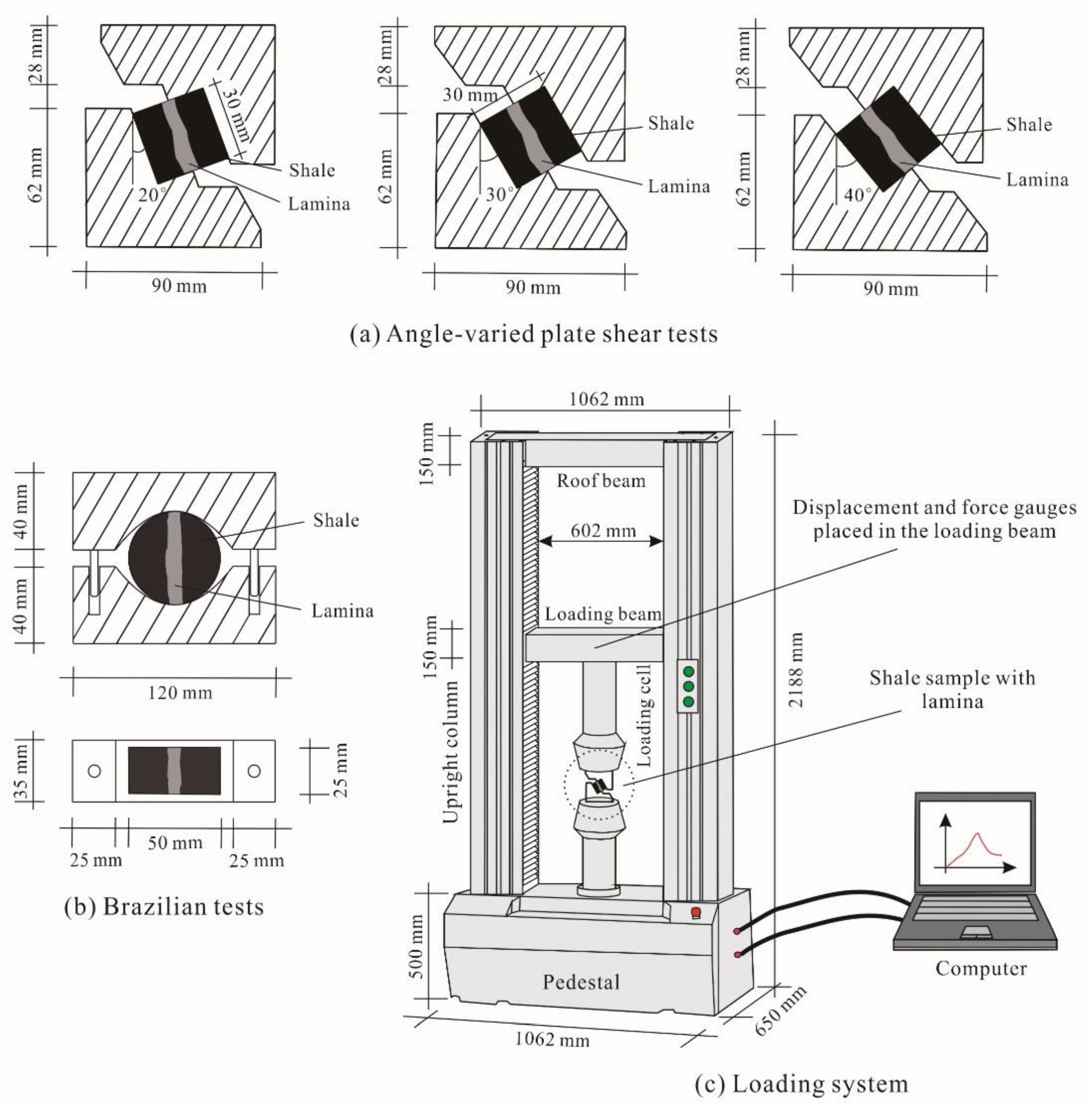
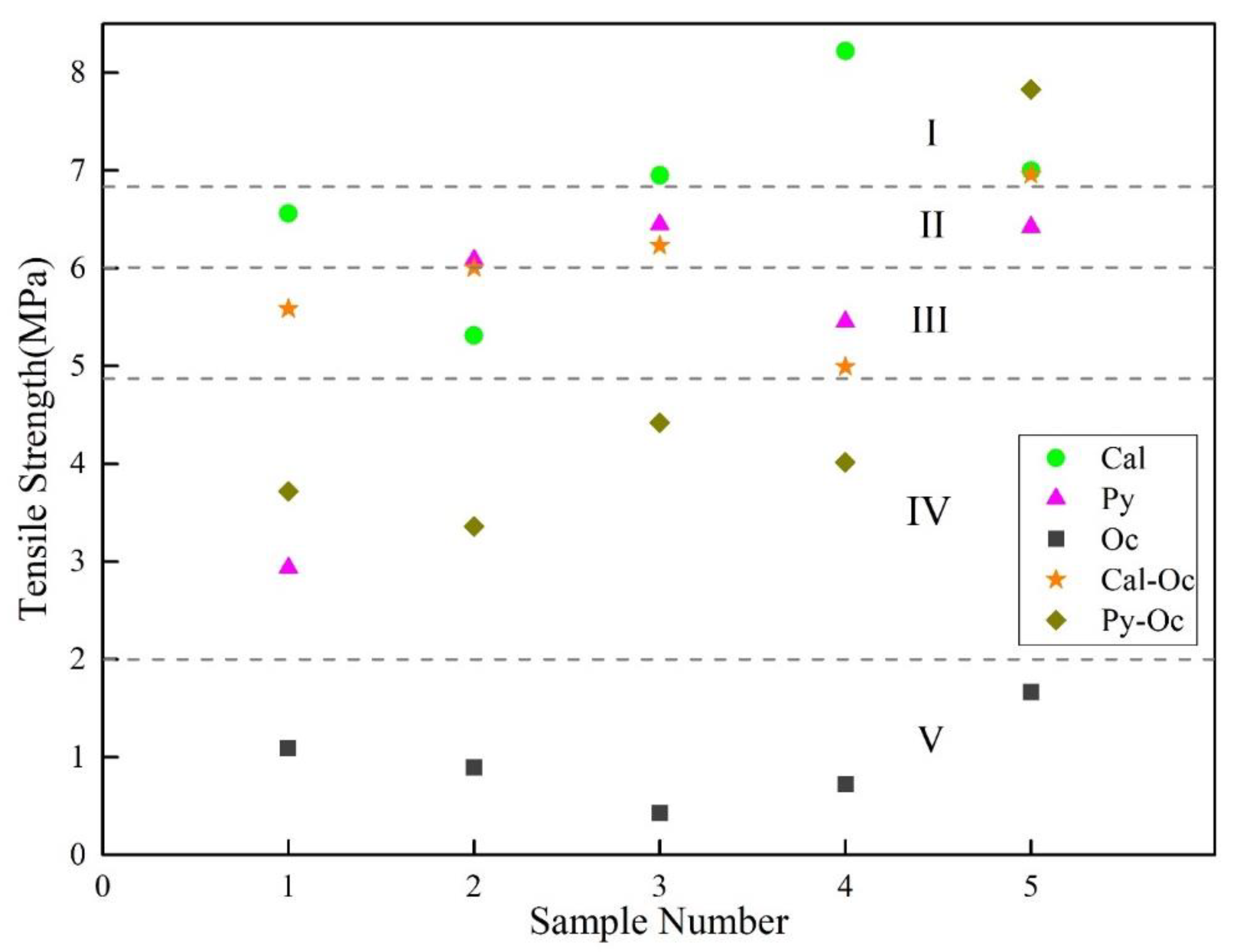
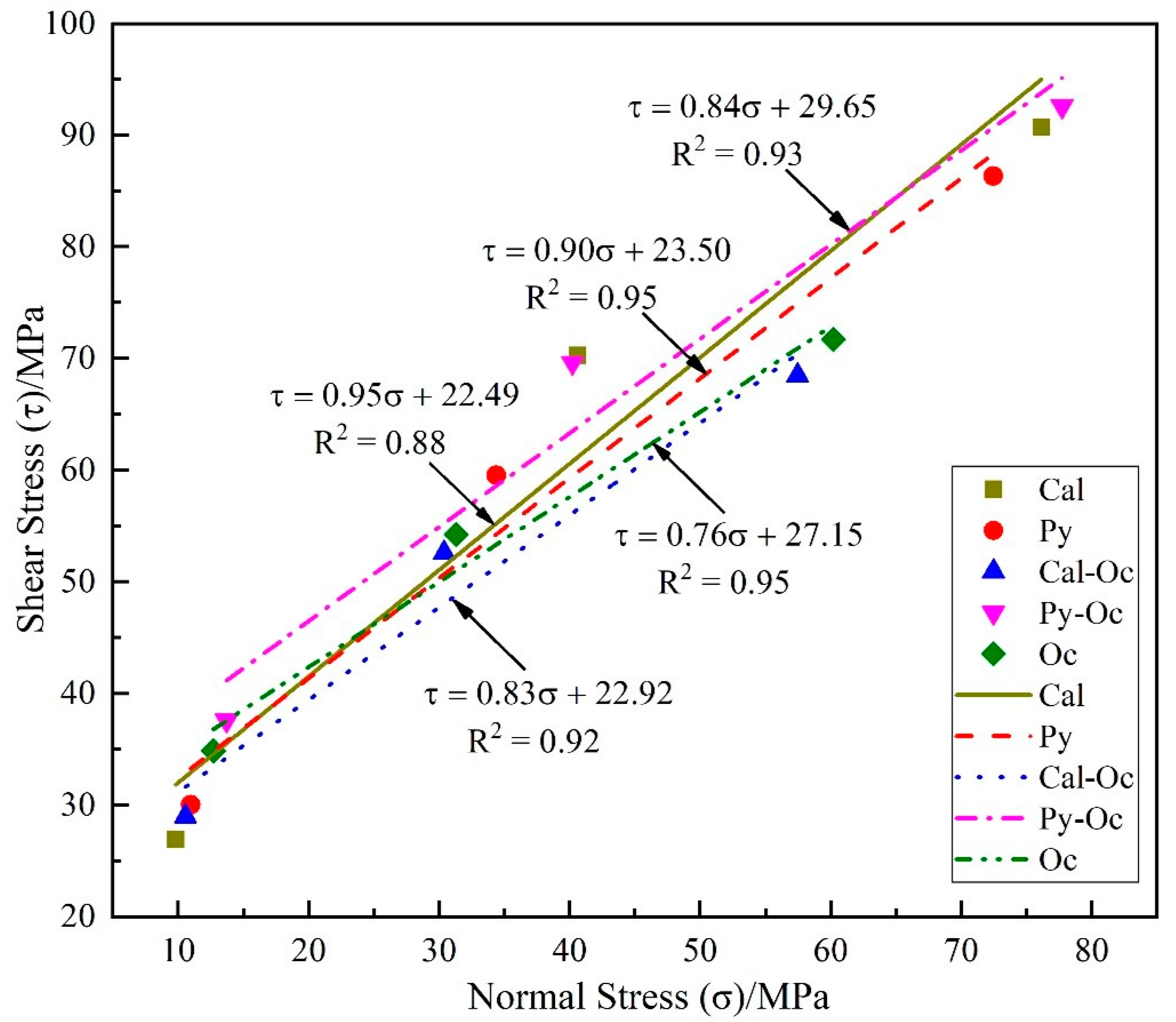
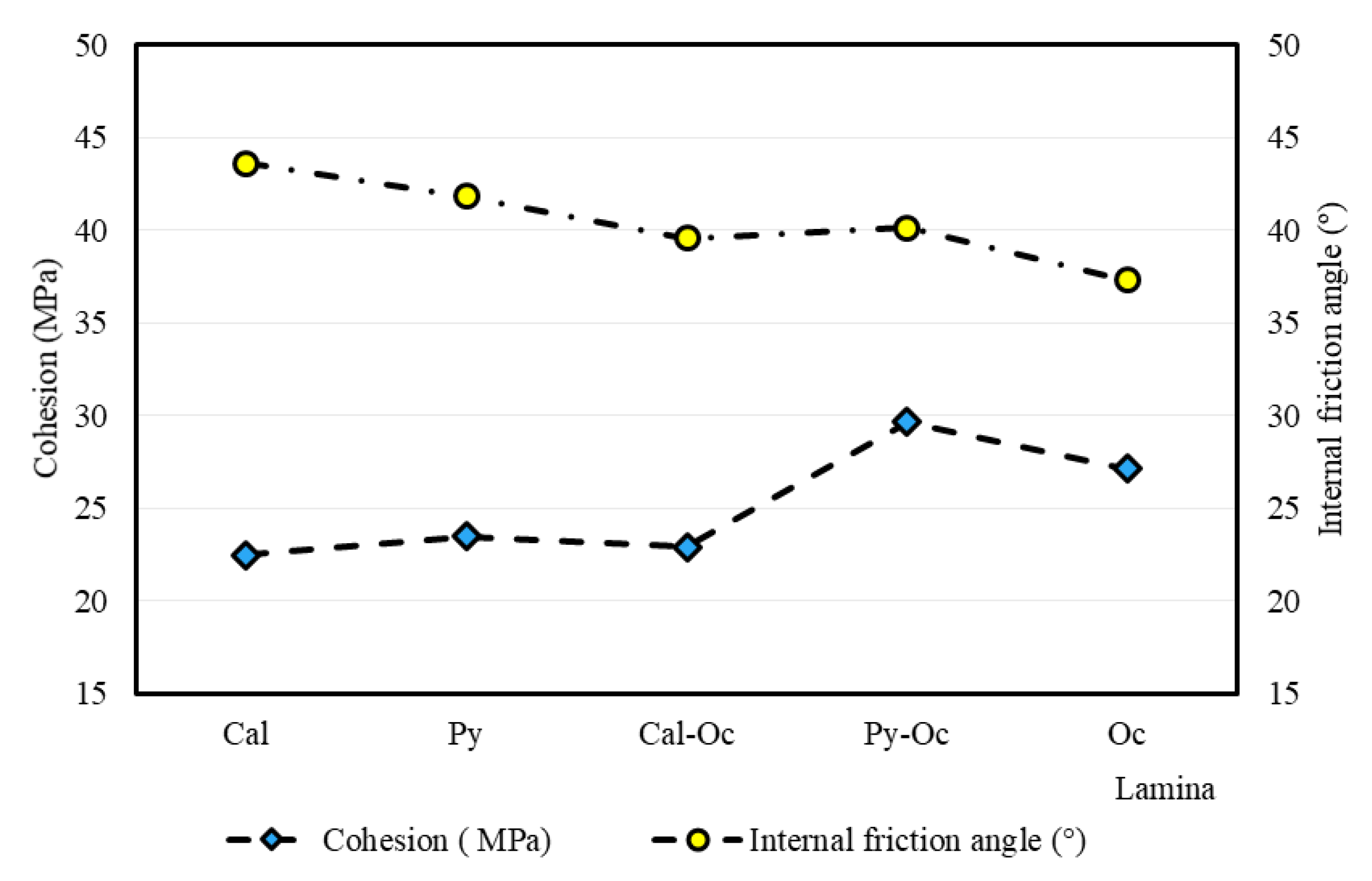
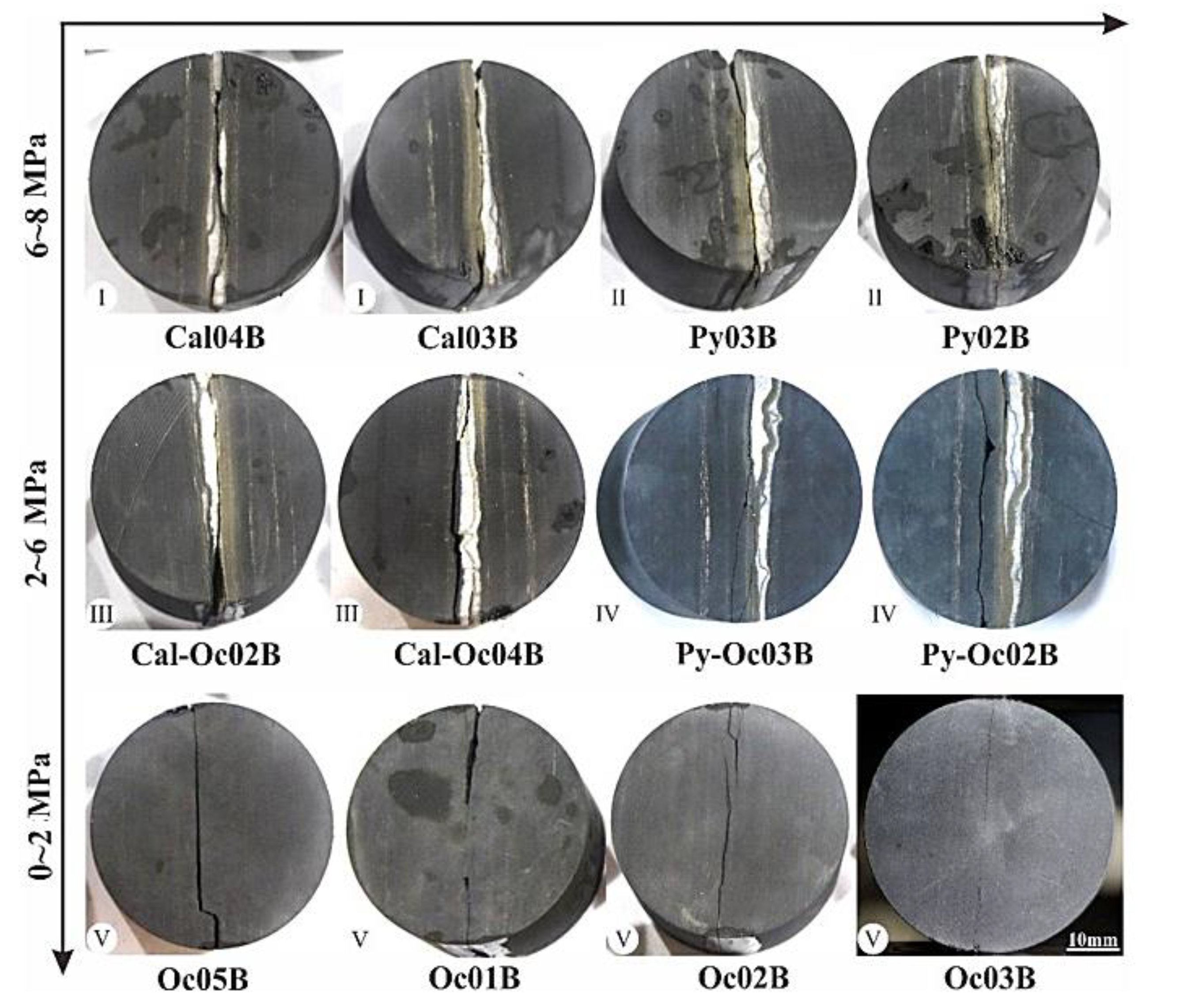

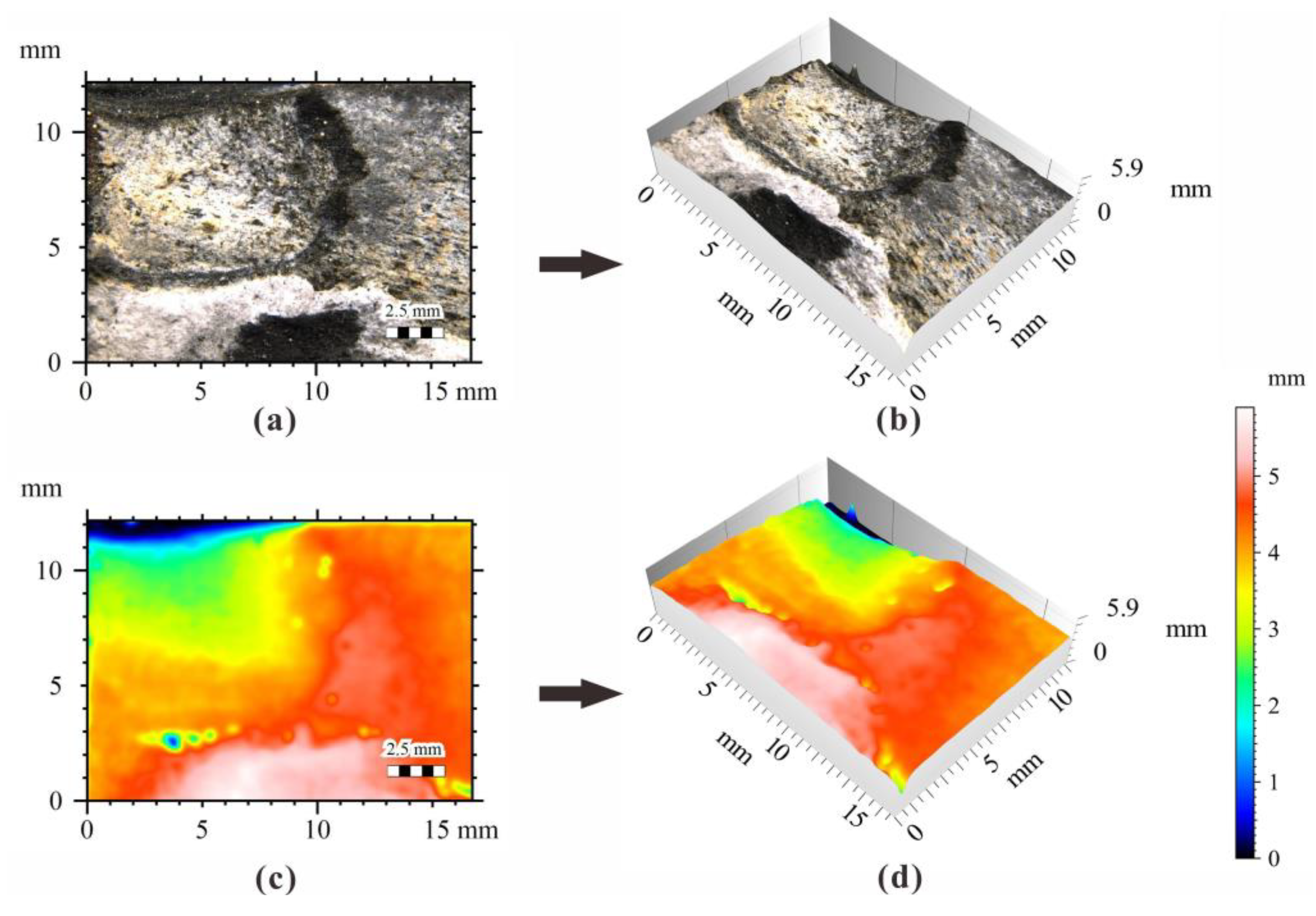
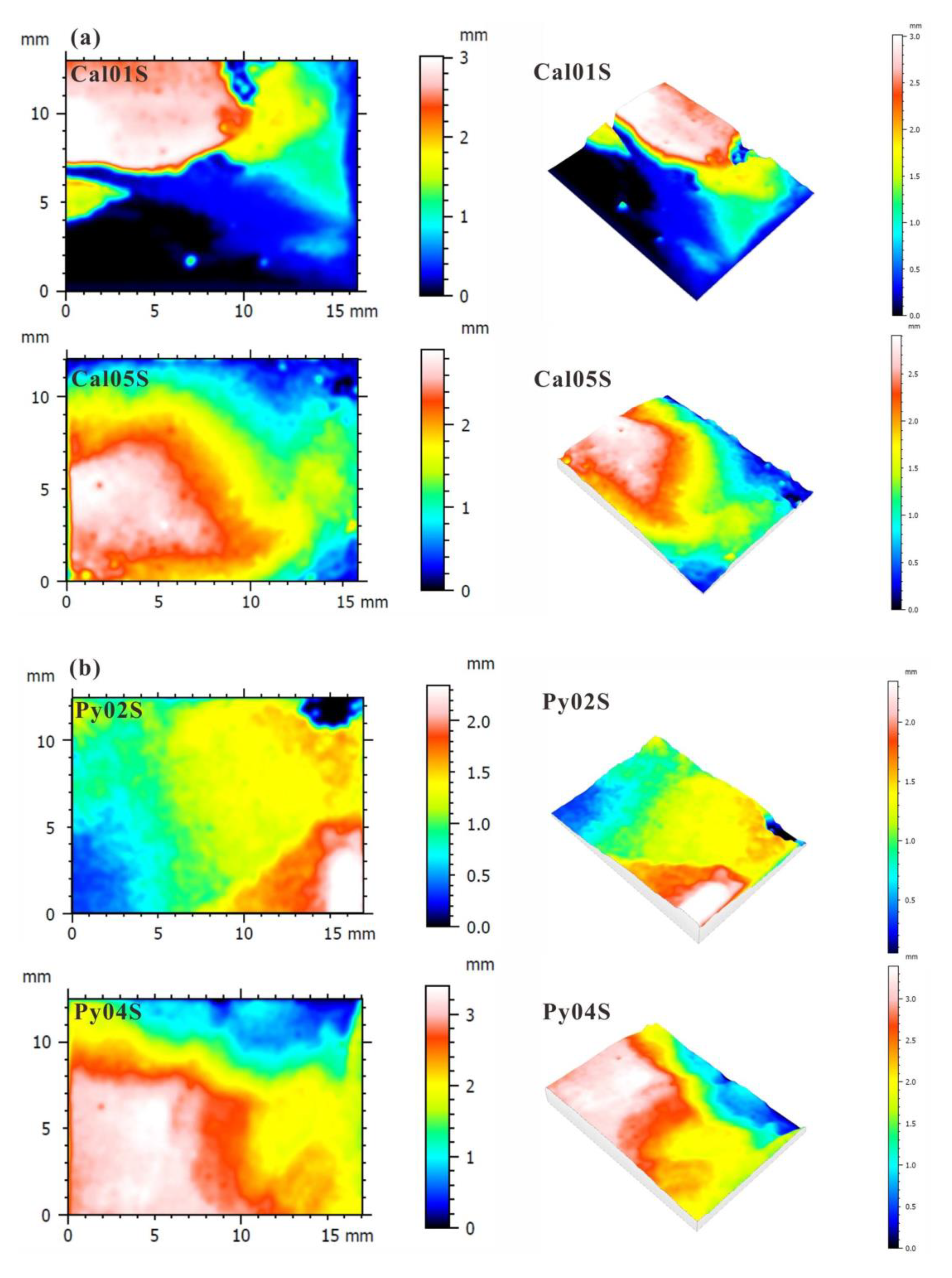
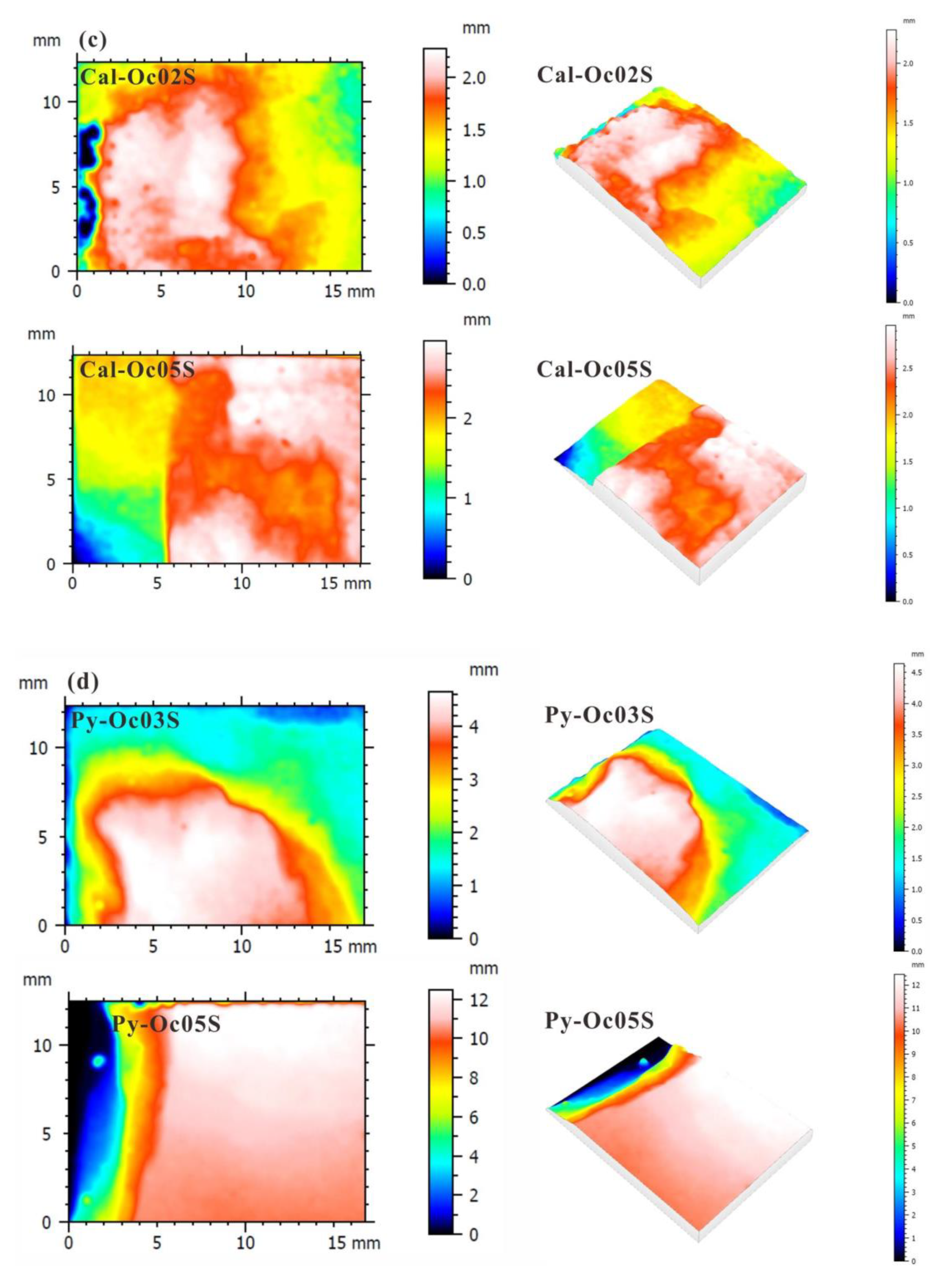


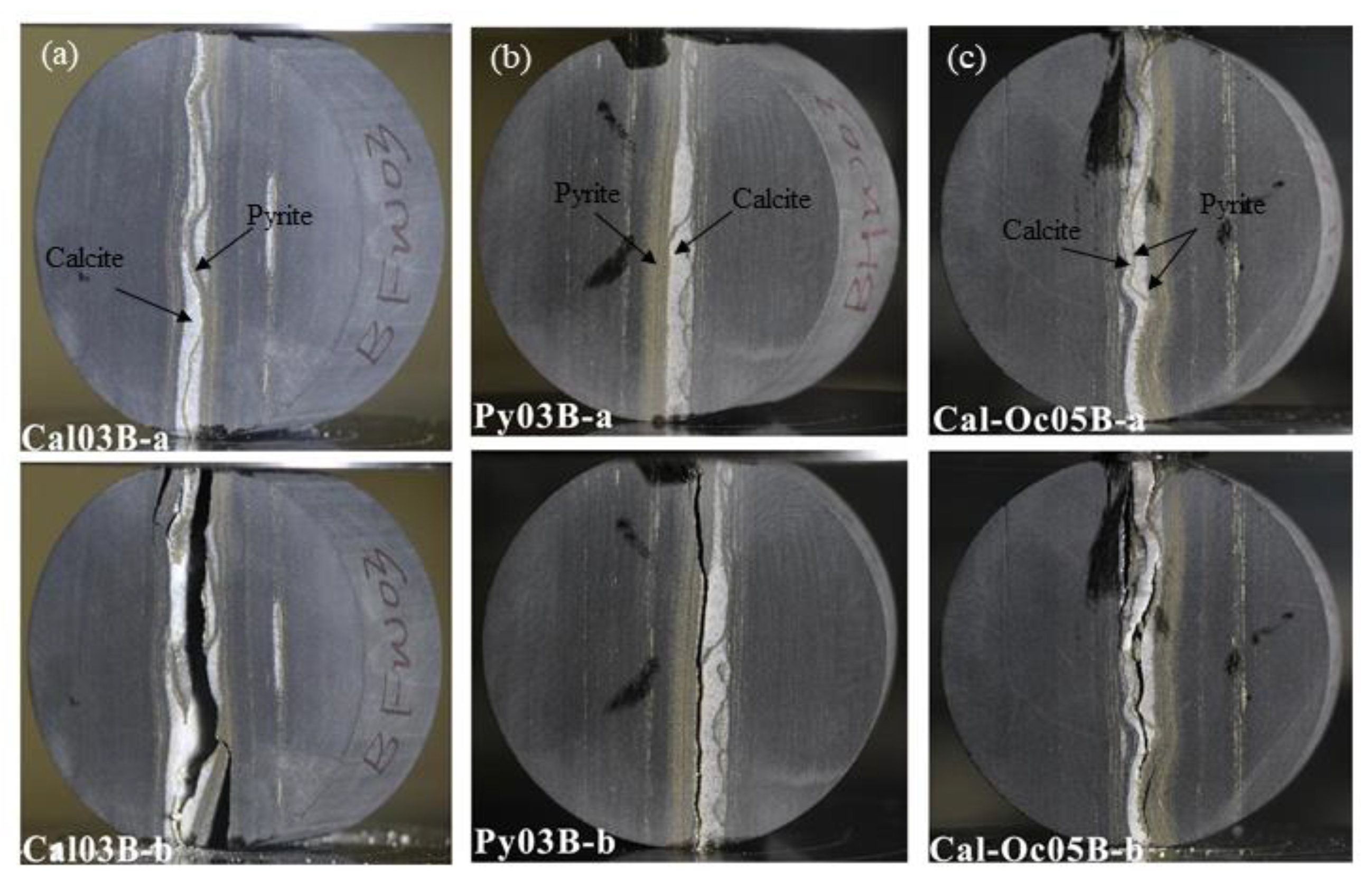
| Laminae Type | Designed Sample Number | Designed Tensile Strength (MPa) | Average Designed Tensile Strength (MPa) | Realigned Sample Number | Realigned Tensile Strength (MPa) | Realigned Average Tensile Strength (MPa) |
|---|---|---|---|---|---|---|
| Cal | Cal01B | 6.56 | 6.81 | Cal03B | 6.95 | 7.39 |
| Cal02B | 5.31 | Cal04B | 8.22 | |||
| Cal03B | 6.95 | Cal05B | 7.00 | |||
| Cal04B | 8.22 | Cal-Oc05B | 6.96 | |||
| Cal05B | 7.00 | Py-Oc05B | 7.83 | |||
| Py | Py01B | 2.94 | 5.47 | Cal01B | 6.56 | 6.35 |
| Py02B | 6.09 | Py02B | 6.09 | |||
| Py03B | 6.45 | Py03B | 6.45 | |||
| Py04B | 5.45 | Py05B | 6.42 | |||
| Py05B | 6.42 | Cal-Oc03B | 6.23 | |||
| Cal-Oc | Cal-Oc01B | 5.58 | 5.95 | Cal02B | 5.31 | 5.47 |
| Cal-Oc02B | 6.00 | Py04B | 5.45 | |||
| Cal-Oc03B | 6.23 | Cal-Oc01B | 5.58 | |||
| Cal-Oc04B | 4.99 | Cal-Oc02B | 6.00 | |||
| Cal-Oc05B | 6.96 | Cal-Oc04B | 4.99 | |||
| Py-Oc | Py-Oc01B | 3.72 | 4.67 | Py01B | 2.94 | 3.69 |
| Py-Oc02B | 3.36 | Py-Oc01B | 3.72 | |||
| Py-Oc03B | 4.42 | Py-Oc02B | 3.36 | |||
| Py-Oc04B | 4.01 | Py-Oc03B | 4.42 | |||
| Py-Oc05B | 7.83 | Py-Oc04B | 4.01 | |||
| Oc | Oc01B | 1.09 | 0.96 | Oc01B | 1.09 | 0.96 |
| Oc02B | 0.89 | Oc02B | 0.89 | |||
| Oc03B | 0.43 | Oc03B | 0.43 | |||
| Oc04B | 0.72 | Oc04B | 0.72 | |||
| Oc05B | 1.66 | Oc05B | 1.66 |
| Lamina Type | Cal | Py | Cal-Oc | Py-Oc | Oc |
|---|---|---|---|---|---|
| Cohesion (MPa) | 22.50 | 23.50 | 22.92 | 29.64 | 27.15 |
| Internal friction angle (°) | 43.60 | 41.83 | 39.57 | 40.13 | 37.29 |
| Brazilian Tensile Strength Level | Designed Central Interlayer | Fracture Morphology Features |
|---|---|---|
| I (7–8 MPa) | Cal | Tortuous fractures along fluctuate Cal-Py |
| II (6–7 MPa) | Py | Tortuous fractures along fluctuate interfaces consisting of ~1/2 Cal-Py and ~1/2 Py |
| III (5–6 MPa) | Cal-Oc | Straight fractures nearly along Cal-Py or Fractures turning from Cal-Py into Py-Oc with low-density pyrite |
| IV (2–5 MPa) | Py-Oc | Fractures turning from straight Cal-Py into Oc or just along Py-Oc containing low-density pyrite |
| V (0–2 MPa) | Oc | Straight tension fractures and local shear fractures |
| Lamina Type | Cal | Py | Cal-Oc | Py-Oc | Oc |
|---|---|---|---|---|---|
| Fracture surface roughness (mm) | 0.58 | 0.67 | 0.56 | 1.09 | 0.26 |
© 2020 by the authors. Licensee MDPI, Basel, Switzerland. This article is an open access article distributed under the terms and conditions of the Creative Commons Attribution (CC BY) license (http://creativecommons.org/licenses/by/4.0/).
Share and Cite
Li, L.; Huang, B.; Huang, X.; Wang, M.; Li, X. Tensile and Shear Mechanical Characteristics of Longmaxi Shale Laminae Dependent on the Mineral Composition and Morphology. Energies 2020, 13, 2977. https://doi.org/10.3390/en13112977
Li L, Huang B, Huang X, Wang M, Li X. Tensile and Shear Mechanical Characteristics of Longmaxi Shale Laminae Dependent on the Mineral Composition and Morphology. Energies. 2020; 13(11):2977. https://doi.org/10.3390/en13112977
Chicago/Turabian StyleLi, Lihui, Beixiu Huang, Xiaolin Huang, Ming Wang, and Xiao Li. 2020. "Tensile and Shear Mechanical Characteristics of Longmaxi Shale Laminae Dependent on the Mineral Composition and Morphology" Energies 13, no. 11: 2977. https://doi.org/10.3390/en13112977






